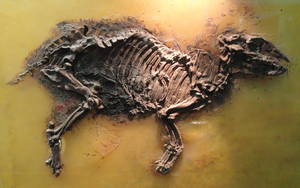The fossilised remains of a 47 million year old pregnant horse complete with its placenta and foal has been uncovered by  researchers in Germany.
researchers in Germany.
Working in what was a lake in the Eocene time, but which is now a celebrated fossil site, a team led by Senckenberg Research Institute scientist Dr Lorenz Franzen unearthed the intact remains of an ancient horse.
X-ray-based imaging also revealed an unborn foal preserved within what was the uterus of its pregnant mother. All the bones of the foal were intact and positioned as they would have been in the womb.
"These photos showed a large black shadow exactly at the position where the utero-placenta should be," says Franzen, "and black shadows of this kind are indicative of soft body preservation."
But the images also give insight into the foal's death and its mother's life. The outer wall of the uterus shows a fine wrinkling pattern. In modern horses this occurs when amniotic fluid escapes. And because the foal did not have its front legs extended in birth position, the amniotic sac must have burst for reasons other than birth - possibly during the death of the mother.
Details of her anatomy revealed which features of the ancient skeletons of this species of horse, Eurohippus messelensis, could be used to determine sex, enabling the team to establish the genders of 60 other horses from the site. This allowed them to understand the social structure of ancient horse herds.
"They might not have had yet the so called harem structure, where there is one dominating stallion which has an entourage of a lot of mares, but that it was more in a balance, the presence of males and females in the same herd," says Franzen.
This site, Grube Messel, produces exceptional fossils today due to the process that once was occurring on the bottom of the ancient lake. Bacteria living on decomposing tissue drew iron from the water, depositing a layer of the mineral on the surface of the organism. This iron left an image in the rock identical to the original creature after it decayed.
"By the activity of the bacteria, we get a really vivid picture of those animals which lived 47 million years ago. We know that the kind of birth process is really comparable with what we know of living horses, so at that early time these kinds of processes were already present."










Comments
Add a comment